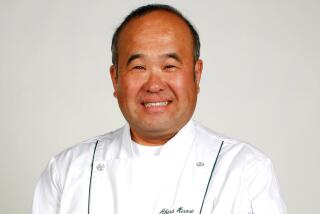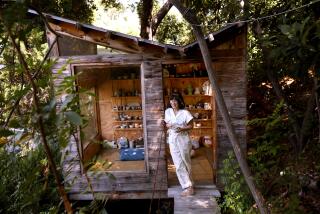Into a Magical World of Cedars and Sashimi
- Share via
“When it snows, the trees look like spindly white flowers on long, straight stems,” Lee says, twisting a piece of jade on the end of a gold chain as we look over the menu at Kitayama. “There’s something exquisite about them, though it’s completely unnatural.”
She is talking about the cedars of Kyoto, Japan. The perfectly shaped trees that are carefully cultivated to produce tall trunks straight as arrow shafts with no branches or leaves except at the very top. They are called Kitayama cedars and have been used for centuries as pillars in the tearooms and famed Buddhist temples of the ancient city of Kyoto. Or so Lee tells me. I have never been to Japan.
I love taking Lee to Japanese restaurants like Kitayama because she always turns our dining experience into a lesson on Asian culture. She is a bento box of knowledge, offering up tidbits of Japanese literature and art to go along with our dishes of sashimi, tempura and sushi. I have only to wait for each little dish to arrive before learning another piece of exotic Japanese trivia. For instance, when the young kimono-clad waitress pours our green tea, I question her about the meal being served to three Japanese businessmen at the next table, and she says it is “kaiseki,” and then bows and leaves.
“I can’t find kaiseki on the menu,” I tell Lee while munching soybeans.
“It’s not on the menu,” Lee says. “You have to ask for it. Usually a day in advance. It’s a big production--eight, 10 courses. When a Kyoto businessman wants to close a big deal, he’ll take a client to a good restaurant and order the kaiseki dinner, which can take all night. Usually it’s accompanied with a lot of Johnny Walker. Or sake.”
This certainly seems true of the businessmen beside us who look a bit flushed and disheveled and have their own little beverage cart with a large thermos of what looks like hot sake. When one of the men goes to smoke a cigarette in the garden that surrounds the dining room, he fails to notice that the sliding doors are closed and bangs hard into the glass like a confused bird. Two of the waitresses in kimonos come over and help the businessman, who is holding his nose, back to his table.
Lee and I look at each other and suppress a laugh. Not wanting an eight-course extravaganza, I order one of the restaurant’s combination dinners with sashimi, shrimp tempura, and sushi, while Lee tells me about Kitayama cedars, leaving it for me to connect the restaurant’s name with the warm white wood decor of the dining room.
“There is a rather well-known Japanese novel,” Lee says, removing the wooden cup from her bowl of miso soup, “called ‘The Old Capital’ about a woman who seems to be a wallflower and so has no suitors. Yet she has a great inner beauty and eventually one man takes the time and effort to see it, finally bringing her out of her shell. Of course, the author never says that. Instead, he talks about the snow-covered Kitayama cedars. Which have the same hidden beauty.”
Lee has a metaphorical nature and appreciates the subtle complexity of almost all things Japanese. For instance, in her garden is a stone washbasin, called a tsukubai, with a rectangular opening full of water in the center and four Japanese characters around it. It looks very simple and most people pay more attention to the azaleas planted around it than the washbasin, not realizing that it is actually a very clever crossword puzzle, of sorts, and if you combine the character of the mouth-like opening with the characters placed at the four corners, you get an old Buddhist saying: “I know and am content with who I am.”
This is something Lee bought for herself when a man she was in love with broke her heart and left her. Most women would buy new clothes or a new car in similar circumstances, but Lee bought a stone washbasin. Just to remind herself of who she was. And that she was OK with that.
There is a full moon hanging like a Japanese lantern over the glassy pond in the garden on the opposite side of the plate glass windows that run the length of the dining room. “We used to have moon-viewing parties when I lived in Kyoto,” Lee says, staring out at the brightly lit garden. “In March or April when the cherry blossoms bloomed, people would hang these red lanterns from the lattice windows of their homes and businesses to mark the arrival of spring, and we would go out late at night and lie on our backs under the trees and just look at the moon. Can you imagine?”
She shakes her head wistfully and says, “God, that seems like about a hundred years ago. I wonder if they still do that?”
“You should go back and find out,” I tell her.
Lee skillfully pinches her chopsticks to lift a tender piece of halibut sashimi. “Oh, I don’t know,” she says. “I’ve heard Kyoto’s changed. That it’s gotten as modern and ugly as Tokyo. I prefer remembering the plovers dancing along the river and the shops selling triangular rice cakes with adzuki beans on top and the clop-clop of young girls walking in their wooden shoes.”
“And the snow falling on cedars,” I say.
“And the snow falling on cedars,” Lee says, smiling. “Sometimes it’s better to remember things the way they were rather than the way they are.”
It’s late. The three businessmen are still knocking back the sake while dipping thin slices of beef into a savory pot of broth over a chafing dish. Neither Lee nor I are able to finish our dinner, so we have it boxed up, though I am not at all sure how well the delicate assortment of sushi and leftover tempura will be the next day.
In the parking lot, Lee and I try to decide if we have the energy to go to a movie, as we had originally planned. The night is warm, the sky is clear. It seems a shame to spend such a rare evening inside.
“Why don’t we have a moon-viewing party?” I suggest.
Lee laughs. “Where?”
“In your garden.”
“That’s crazy,” she says. But that’s exactly what we end up doing, picking at the leftover sushi while looking at the constellations. When I have finished the last little morsel of fish, I wash my hands in Lee’s stone washbasin. Then I lie on my back, next to Lee, staring at the waxing moon.
Lunch Monday-Friday, 11:30 a.m.-2 p.m. Dinner Monday-Friday, 6-10 p.m.; Saturday, 5:30-10 p.m.; Sunday, 5:30-9:30 p.m.
More to Read
Eat your way across L.A.
Get our weekly Tasting Notes newsletter for reviews, news and more.
You may occasionally receive promotional content from the Los Angeles Times.








